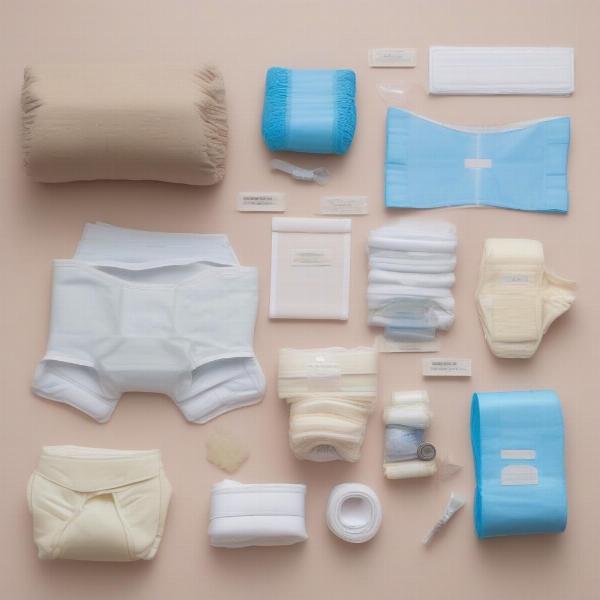Dog incontinence nappies are a practical solution for managing urinary or fecal incontinence in dogs. Whether your furry friend is a senior experiencing age-related issues, a puppy still learning bladder control, or dealing with a medical condition, dog nappies can significantly improve both your dog’s comfort and your home’s hygiene. This comprehensive guide will explore everything you need to know about choosing the right nappies, proper usage, and ensuring your dog’s well-being.
Understanding Dog Incontinence and the Need for Nappies
Why might a dog need nappies? Several factors can contribute to canine incontinence, including old age, medical conditions like urinary tract infections or diabetes, hormonal imbalances, spinal injuries, and even certain medications. For puppies, bladder control is a learned behavior and accidents are common during the house-training phase.
Incontinence can be distressing for both dogs and their owners. Nappies provide a discreet and hygienic way to manage leaks and accidents, protecting your furniture and carpets while keeping your dog clean and comfortable. They can also boost a dog’s confidence, allowing them to participate in family activities without the worry of accidents.
Choosing the Right Dog Incontinence Nappies
Selecting the right nappy is crucial for both effectiveness and your dog’s comfort. Consider the following factors:
- Size and Fit: Measure your dog’s waist and refer to the manufacturer’s size chart to ensure a snug but not restrictive fit. A properly fitted nappy should be comfortable and prevent leaks.
- Absorbency: Different nappies offer varying levels of absorbency. Choose a nappy with the appropriate absorbency level based on your dog’s needs and the frequency of their incontinence.
- Material: Disposable nappies are convenient for easy cleanup, while washable nappies are a more eco-friendly option. Consider your lifestyle and preferences when choosing the material.
- Features: Some nappies have features like leak guards, adjustable straps, or wetness indicators that can enhance their effectiveness and convenience.
 Different types of dog incontinence nappies
Different types of dog incontinence nappies
Using Dog Incontinence Nappies Effectively
Once you’ve chosen the right nappy, proper usage is essential to prevent leaks and ensure your dog’s comfort. Follow these steps:
- Introduce the Nappy Gradually: Allow your dog to sniff and investigate the nappy before attempting to put it on. Positive reinforcement with treats and praise can help create a positive association.
- Ensure a Secure Fit: The nappy should fit snugly around your dog’s waist without being too tight. Adjust the straps or fasteners as needed to achieve a comfortable and secure fit.
- Change Regularly: Change the nappy as often as necessary to prevent skin irritation and maintain hygiene. This will depend on the frequency of your dog’s incontinence and the absorbency of the nappy.
- Monitor for Skin Irritation: Regularly check your dog’s skin for any signs of redness, rash, or irritation. If you notice any issues, discontinue use and consult your veterinarian.
Maintaining Hygiene and Comfort
Using dog incontinence nappies can greatly improve hygiene, but it’s crucial to maintain a consistent cleaning routine:
- Clean Your Dog After Each Change: Gently clean your dog’s genitals and surrounding area with a pet-friendly wipe or warm, damp cloth.
- Use a Barrier Cream (If Needed): If your dog is prone to skin irritation, applying a pet-safe barrier cream can help protect their skin.
- Keep the Area Dry: Ensure the area around the nappy is clean and dry to prevent bacterial growth and skin issues.
Addressing Common Concerns about Dog Nappies
“My dog hates wearing nappies!” This is a common concern among pet owners. Patience and positive reinforcement are key. dog incontinence diapers Start by introducing the nappy gradually, rewarding your dog with treats and praise. Make sure the nappy fits properly, as an ill-fitting nappy can be uncomfortable.
“Aren’t nappies embarrassing for my dog?” While it might seem unusual at first, dogs don’t experience embarrassment the same way humans do. The priority is their comfort and well-being. pet parents washable dog diapers With a properly fitted nappy, your dog can enjoy a more active and social life without the worry of accidents.
Conclusion
Dog incontinence nappies are a valuable tool for managing incontinence and improving the quality of life for both dogs and their owners. By understanding the different types of nappies available, choosing the right fit, and implementing proper usage techniques, you can help your furry friend stay comfortable, confident, and clean. dog nappies nz Remember to consult with your veterinarian to rule out any underlying medical conditions and to discuss the best management strategy for your dog’s specific needs.
FAQ
- How often should I change my dog’s incontinence nappy? This depends on the severity of the incontinence and the absorbency of the nappy. Generally, changing the nappy every 3-4 hours, or as soon as it’s soiled, is recommended.
- Can male dogs wear nappies? Yes, there are nappies specifically designed for male dogs, often called belly bands or wraps.
- Are washable nappies better than disposable ones? Both have their pros and cons. disposable dog diapers female Disposable nappies are convenient but generate more waste. Washable nappies are more eco-friendly but require laundering.
- My dog keeps trying to remove the nappy. What should I do? Make sure the nappy fits correctly and isn’t too tight or loose. Distract your dog with play or treats, and praise them when they leave the nappy alone.
- Can I use human baby nappies on my dog? It’s generally not recommended, as they don’t fit dog anatomy properly and could leak. dog bladder anatomy
About ILM Dog
ILM Dog (ilmdog.com) is your trusted resource for expert advice on dog care and wellbeing, covering everything from breed selection and health to training and nutrition. We are dedicated to providing practical, evidence-based information to help you navigate every stage of your dog’s life. For personalized guidance and support, reach out to our team at [email protected] or call us at +44 20-3965-8624.